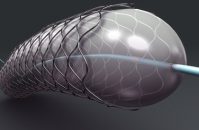Courtesy of Dr. Carlos Fava. Aortic stenosis with cardiac failure or cardiogenic shock involves high mortality risk at short term. Surgery in these conditions is often unsafe, which leaves us with valvuloplasty, but only as a bridge to some other procedure, seeing as it is effective only for a short time. Few studies have looked into patients undergoing…
The Largest Registry on the ACURATE neo Valve
Transcatheter aortic valve replacement (TAVR) using the ACURATE neo device depends, largely, on correct patient selection and appropriate oversizing. The individual anatomy of each patient, namely periannular and aortic root calcification, must be taken into account. The ACURATE neo valve (Symetis/Boston, Ecublens, Switzerland) is a new-generation self-expanding valve characterized by a stent design shaped as an X…
Are the Rates of Stroke Similar in TAVR and Surgery?
Courtesy of Dr. Carlos Fava. Stroke is one of the most undesirable complications we can face and, regarding transcatheter aortic valve replacement (TAVR), major studies presented have rates of stroke of about 4%. In others, rates have been slightly higher. This meta-analysis included 5 randomized studies between 2011 and 2017: PARTNER, CoreVALVE, NOTION, PARTNER 2, and SURTAVI.…
Leaflet Laceration, an Extreme Measure to Avoid Coronary Occlusion After TAVR
Intentional leaflet laceration before mounting the prosthesis on the release system, so as to reduce the risk of acute coronary occlusion, seems a desperate maneuver to force transcatheter aortic valve replacement (TAVR). Unfortunately, we will always encounter patients without other real choice; in those cases, creativity may start as compassionate treatment and then be upgraded…
EuroPCR 2018 | SAPIEN 3 in bicuspids
First generation TAVR procedures performed on patients with bicuspid aortic valve stenosis have rendered suboptimal outcomes. In addition, studies on new generation devices, such as the SAPIEN 3, have systematically excluded these patients from their protocols. Therefore, we are missing information about TAVR on bicuspid aortic valve stenosis patients. This study compared SAPIEN 3 TAVR…
EuroPCR 2018 | SENTINEL: Anatomical Predictors of Stroke during TAVR
The rate of cerebrovascular events in TAVR hovers about 4% in most of the current studies, regardless the center, the operator or the prosthetic valve. At present, no scores can adequately predict which patients run the highest risk of stroke during TAVR, and the routine use of cerebral protection devices remains controversial. The SENTINEL study…
EuroPCR 2018 | Meta-Analyzis on Cerebral Protection Devices during TAVR
The risk of stroke is inherent to TAVR and, apart from clinically manifest events, there is abundant evidence of cerebral embolic lesions during TAVR provided by studies using diffusion weighted MRI or transcranial doppler ultrasound. Several devices have been developed to reduce the risk of stroke, though they have been assessed by relatively small trials…
EuroPCR 2018 | NOTION: Good TAVR Durability Compared with Surgically-Implanted Valve in Low-Risk Patients
Several studies are defining the role of transcatheter aortic valve replacement (TAVR) in patients with low surgical risk. One of the main concerns for this population, whose life expectancy is much longer, has to do with TAVR durability compared with a surgically-implanted biological valves. The Nordic Aortic Valve Intervention (NOTION) trial was the first study…
Is TAVR Durable Beyond 5 Years?
Courtesy of Dr. Carlos Fava. The benefits derived from transcatheter aortic valve replacement (TAVR) are clear and self-evident, and its progressively better outcomes are due to better patient selection, greater operator experience, and the development of new valves that enhance procedural safety and complexity. However, the question of durability remains a major unresolved issue, particularly now…
Baseline Pulmonary Hypertension Should Not Preclude TAVR
Pulmonary hypertension (PH) in patients with severe aortic stenosis undergoing transcatheter aortic valve replacement (TAVR) should not preclude this procedure. In fact, TAVR will resolve this condition in most cases. More than three quarters of patients undergoing TAVR have some level of PH, though this has not been associated to increased mortality, according to this…









